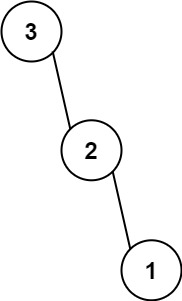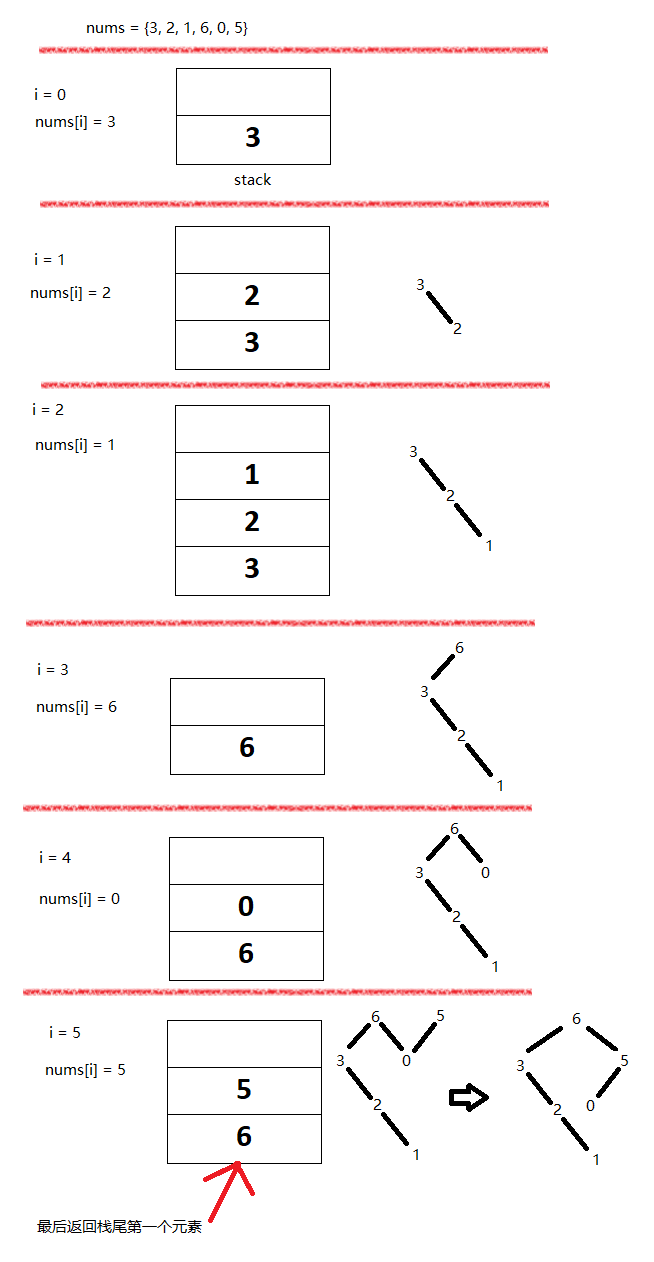LeetCode - Medium - 654. Maximum Binary Tree
Topic
- Tree
Description
https://leetcode.com/problems/maximum-binary-tree/
You are given an integer array nums with no duplicates. A maximum binary tree can be built recursively from nums using the following algorithm:
- Create a root node whose value is the maximum value in
nums. - Recursively build the left subtree on the
subarray prefixto theleftof the maximum value. - Recursively build the right subtree on the
subarray suffixto therightof the maximum value.
Return the maximum binary tree built fromnums.
Example 1:

Input: nums = [3,2,1,6,0,5]Output: [6,3,5,null,2,0,null,null,1]Explanation: The recursive calls are as follow:- The largest value in [3,2,1,6,0,5] is 6. Left prefix is [3,2,1] and right suffix is [0,5].- The largest value in [3,2,1] is 3. Left prefix is [] and right suffix is [2,1].- Empty array, so no child.- The largest value in [2,1] is 2. Left prefix is [] and right suffix is [1].- Empty array, so no child.- Only one element, so child is a node with value 1.- The largest value in [0,5] is 5. Left prefix is [0] and right suffix is [].- Only one element, so child is a node with value 0.- Empty array, so no child.
Example 2:

Input: nums = [3,2,1]Output: [3,null,2,null,1]
Constraints:
- 1 <= nums.length <= 1000
- 0 <= nums[i] <= 1000
- All integers in nums are unique.
Analysis
方法一:用到后序遍历模式+暴力查找出最大值。
方法二:很巧妙的方法,类似用到中序遍历模式。link

另外,中序遍历这生成后的树,能得到输入那种序列。
Submission
import java.util.LinkedList;import com.lun.util.BinaryTree.TreeNode;public class MaximumBinaryTree {public TreeNode constructMaximumBinaryTree(int[] nums) {return constructMaximumBinaryTree(nums, 0, nums.length - 1);}private TreeNode constructMaximumBinaryTree(int[] nums, int start, int end) {int maxValueIndex = findMax(nums, start, end);if(maxValueIndex == -1) return null;return new TreeNode(nums[maxValueIndex], //constructMaximumBinaryTree(nums, start, maxValueIndex - 1), //constructMaximumBinaryTree(nums, maxValueIndex + 1, end));}private int findMax(int[] nums, int start, int end) {if(start > end) return -1;int maxValueIndex = start;for(int i = start + 1; i <= end; i++) {if(nums[i] > nums[maxValueIndex])maxValueIndex = i;}return maxValueIndex;}public TreeNode constructMaximumBinaryTree2(int[] nums) {LinkedList<TreeNode> stack = new LinkedList<>();for(int i = 0; i < nums.length; i++) {TreeNode curr = new TreeNode(nums[i]);while(!stack.isEmpty() && stack.peek().val < nums[i]) {curr.left = stack.pop();}if(!stack.isEmpty()) {stack.peek().right = curr;}stack.push(curr);}return stack.isEmpty() ? null : stack.removeLast();}}
Test
import static org.junit.Assert.*;import org.junit.Test;import com.lun.util.BinaryTree;import com.lun.util.BinaryTree.TreeNode;public class MaximumBinaryTreeTest {@Testpublic void test() {MaximumBinaryTree obj = new MaximumBinaryTree();TreeNode actual1 = obj.constructMaximumBinaryTree(new int[] { 3, 2, 1, 6, 0, 5});TreeNode expected1 = BinaryTree.integers2BinaryTree(6, 3, 5, null, 2, 0, null, null, 1);assertTrue(BinaryTree.equals(actual1, expected1));TreeNode actual2 = obj.constructMaximumBinaryTree(new int[] { 3, 2, 1});TreeNode expected2 = BinaryTree.integers2BinaryTree(3, null, 2, null, 1);assertTrue(BinaryTree.equals(actual2, expected2));}@Testpublic void test2() {MaximumBinaryTree obj = new MaximumBinaryTree();TreeNode actual1 = obj.constructMaximumBinaryTree2(new int[] { 3, 2, 1, 6, 0, 5});TreeNode expected1 = BinaryTree.integers2BinaryTree(6, 3, 5, null, 2, 0, null, null, 1);assertTrue(BinaryTree.equals(actual1, expected1));TreeNode actual2 = obj.constructMaximumBinaryTree2(new int[] { 3, 2, 1});TreeNode expected2 = BinaryTree.integers2BinaryTree(3, null, 2, null, 1);assertTrue(BinaryTree.equals(actual2, expected2));}}





























还没有评论,来说两句吧...